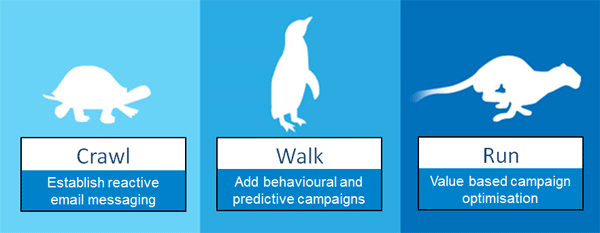
I don’t need to tell you personalization is imperative, nor that personalization no longer means using “dear [first_name]”, right?
Today, personalization means right time, right message marketing targeted to a particular consumer. And it’s worth it: personalized emails deliver six times higher transaction rates.
Personalization at this deeper level has become a Holy Grail for the sophisticated email marketer, yet many marketers struggle to get to that level. Less than 10% of top retailers rank themselves highly effective at it.
Perhaps marketers need to take a step back and implement personalization in stages, growing in sophistication… and results. With that in mind, let’s talk about taking a crawl, walk, run approach to improving your email personalization.
You need an ESP, not a “marketing cloud”
First off, you need to have the right ESP in place, even before you get to the “crawl” stage of personalization. By that I don’t mean an ESP that’s going to offer you all kinds of functionality for personalization. Rather, I mean an ESP that can provide the foundation for your other efforts.
There was a time when an ESP allowed marketers to send emails and track results. Then ESPs evolved into a kind of “one-stop shopping” platform that offered everything cross channel as well as countless bells and whistles. In theory, that sounds like a great idea, putting all the functionality you might want across channels into one platform.
The two biggest downsides with that approach is that it’s a challenge for an ESP turned marketing cloud to do everything well. The “marketing-cloud” vendor is likely to charge you for their complete package, not just what you want to use. In addition, several marketing clouds are now are also charging for numbers of contacts and amounts of file storage, along with the incremental email cost.
It isn’t necessary to have all functionality one cloud platform when an integration is easily made or there are third-party vendors developing innovative additions that allow marketers to do very specific things.
In my opinion, with all of the third-party options you have these days, you don’t need the be-all, do-all marketing cloud kind of ESP. You only need a best-in-class ESP that’s scalable, integrates well with other technologies, and is chiefly a highly functional email deliverability provider.
Once you have that in place, you can start adding on the technology, data and strategy needed to improve your personalization.
Your personalization goal
Your first layer of technology is your best-in-class ESP, as described above. Your second layer is technology that collects data and makes decisions in real-time. With that, you’re going to pursue your goal: to move your email program from a complacent batch-and-blast approach to a proactive one-to-one conversation with your email subscribers.

Making use of email marketing data
Using your ESP and other pieces of your technology stack, you’ll begin by integrating and using the following types of data, starting slow and ramping up until you’re going full speed:
- Email engagement and preference center data
- Data from your website e-commerce platform, Point-of-Sale system (POS), and Order Management System (OMS)
- Ad-hoc data from CRM, OMS, POS, and Beacon technology
Reaching the ultimate goals of personalization is not something that happens overnight, so we encourage utilizing a crawl, walk, run approach to implementation. We’ve outlined each of these three steps below and described what they might look like:
Step 1: The Crawl
This first step is when you’re using reactive campaigns utilizing on-site behavior as well as CRM and ESP data. We call these campaigns reactive because they are based on behavior (or lack of behavior). This first step includes using emails for:
- Welcome series
- Cart abandonment
- Checkout abandonment
- Re-engagement
- Self-selected preference campaigns such as birthday, anniversary, frequency, gender-specific
- Dynamic content within bulk campaigns (for example, product category, product images based on geographic data, gender)
- Post-purchase win-back campaigns
If you’re already using some or all of these methods, congratulations! You’re off to a great—albeit slow—start.
The next two steps are when you can really begin tailoring your messages to be ever more personalized because this is when you stop being reactive and start being proactive. At the walk and even more so at the run, you can begin tailoring your messages in a one-to-one dialog.
Step 2: The Walk
With this step as you start using proactive campaigns, you begin adding in machine learning for predictive behaviors based on email engagement, on-site behavior, and past purchase behavior:
- Browse abandonment
- Browse affinity campaigns
- Price reduction campaigns (markdown permanently)
- Back in stock campaigns
- Product browsed now on sale (temporary sale)
- Geo Targeted email campaigns
- In-store data triggered campaigns
- Predictive behavior triggered campaigns
- Post-purchase product affinity campaigns
Step 3: The Run
At this point, your proactive campaigns are utilizing machine learning for predictive behaviors based on email engagement, on-site behavior, and post-purchase behavior, but this is where you begin to build out the automations and triggers for very narrow, potentially high-value subsets of your audience:
- Purchase value optimization
- Customer Loyalty/VIP
This degree of personalization, this one-to-one predictive marketing, should be every email marketer’s goal, and you don’t need an ESP with all kinds of bells and whistles to make this happen. You need a good, solid best-in-class ESP that offers stellar deliverability and integrates easily with add-ons and other technologies. And then you need the second layer of technology in the form of add-ons to make it happen.
But before taking the steps described above, it’s critical that you determine your strategy, then nail down the tactical pieces.
